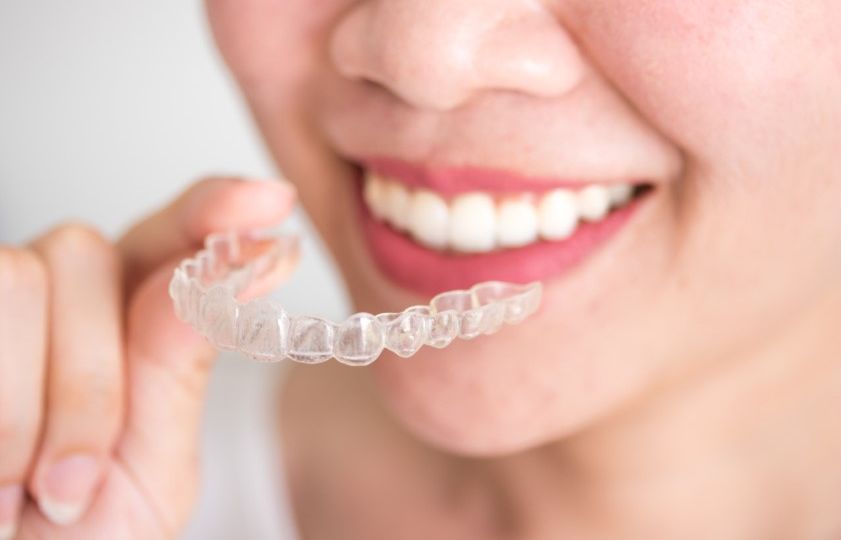
When you start your Invisalign treatment, an adjustment process is necessary and inevitable. Your mouth will need time to adjust to the new pressure of your clear aligners as they begin to add gradual amounts in order to move your teeth. It won’t always feel this way, but while it does, there are many things at your disposal to help ease any pain!
Remember That It’s Short-Lived
If you start to get discouraged, try to remember the initial discomfort won’t last forever. Your mouth will adjust, and you will eventually develop callouses in your mouth that will prevent ongoing discomfort from the edges of your clear aligners rubbing against your gums. If you can persevere and get over the hard part, you’ll enjoy your amazing smile at the end of the process!
Protect Your Tongue and Cheeks
Tongue and cheek irritation typically happens within the first few weeks of wearing Invisalign and can occur for a few days every time you switch to your next set of clear aligners. These sores and ulcers may show up in the form of a red burn-like mark. These sores aren’t serious and can be healed by rinsing with salt water a few times a day to prevent infection and minimize discomfort.
These sores typically happen when there are sharp edges on your clear aligners that need to be smoothed down. Your orthodontist will be happy to do this for you, and it just takes one appointment and a few minutes to complete. Don’t worry – this process won’t change the fit of your aligners or hinder your progress. If you notice anything about your aligners irritating you, please don’t hesitate to call.
Utilize Over The Counter Medications
If needed, you can take over-the-counter medications like ibuprofen or Advil to manage any discomfort. This can be found at any drugstore and should be used only according to the recommended dosage instructions on the label. Try not to make a habit of taking it too frequently, but it can be relied on when you’re in a pinch, or having a particularly uncomfortable day.
Switch Aligners Before Bed
Much of the discomfort that patients can experience during Invisalign treatment comes from having to switch to their new set of aligners. Because your clear aligners add gradual amounts of increased pressure as an important part of your treatment, switching aligners can be uncomfortable, and isn’t always an easy task.
We recommend switching to your new set of aligners before bed. This will give your teeth time to adjust and will let you sleep off any potential immediate discomfort. This will help your mouth adjust to your new Invisalign as you sleep, and hopefully, keep you relatively pain-free for the next day.
Don’t Eat Anything Hard or Crunchy, But Don’t Avoid Chewing, Either!
Especially at first, crunchy foods may be difficult to eat when your mouth is sore. Things like tough meats, popcorn, nuts, candy, raw vegetables, and more have potential to irritate your already sensitive mouth. Many patients find that chewing does provide some relief, however, so don’t avoid it entirely. Even these very small amounts of pressure can help alleviate the pain for a short amount of time. Try steamed vegetables, stews, bread, potatoes, and any other softer favourites to help get you through and avoid further irritation.
Make Sure Your Aligners Are Inserted Correctly

When you receive your aligners, your orthodontist will walk you through how to safely and correctly put them in and remove them. It may be tricky to pin down exactly how to put them in your first few times, so make sure they snap in all the way and are comfortably fitted. When your Invisalign is loose or not snapped in properly, it can put unnecessary pressure on your teeth, and cause more discomfort. An improperly fitted aligner can also move your teeth in the wrong position because it’s not sitting in the right place, and affect the outlined treatment process. If your Invisalign feels wrong or like it isn’t fitting comfortably, please let your orthodontist know as soon as possible so the proper changes can be quickly made.
Wear Your Aligners As Much As Possible
Though it may be the last thing you want to do when your mouth is sore, wearing your clear aligners for as many hours as you can will help you recover and adjust faster. Wearing your aligners for the recommended amount of 22 hours per day will help your teeth shift faster, and help you get used to wearing them at a much quicker pace. Using all of the tips in this blog and keeping your aligners in will help speed up the process, and get you to your final result much faster! Remember your Invisalign should only be removed for eating and drinking anything that isn’t water, and should be worn at all other times of the day for the best results.
Have any questions for us? Please contact us here if you need any help with your Invisalign.



